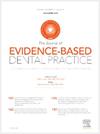A TRIPLE-BLIND RANDOMIZED CLINICAL TRIAL COMPARING THE EFFICACY OF A DESENSITIZING AGENT USED WITH AN AT-HOME BLEACHING TECHNIQUE
IF 4.1
4区 医学
Q1 DENTISTRY, ORAL SURGERY & MEDICINE
引用次数: 0
Abstract
Purpose
The aim of this study was to determine whether a sustained-release desensitizing gel containing 3% potassium nitrate and 0.11% fluoride ion reduces the risk of tooth sensitivity without compromising the effectiveness of bleaching treatment.
Methods
Thirty-two patients were randomly assigned to 2 experimental groups: desensitizing gel and placebo. The desensitizing gel or placebo was applied for 30 minutes prior to the at-home vital bleaching gel application. A nightguard dental bleaching treatment (NGVB) using a 16% carbamide peroxide gel was performed for 6 hours over a 3-week period. Patients recorded their tooth sensitivity daily using a 5-point Numeric Rating Scale (NRS). Whiteness index measurements were obtained using a dental spectrophotometer on the upper canines (right and left).
Results
The overall risk of sensitivity was 37.5% in the desensitizing gel group compared to 87.5% in the placebo group, yielding a relative risk of 0.42 (95% CI 0.22-0.82), showing a statistically significant difference between the groups (P < .05). During the first week, patients in the placebo group exhibited a higher risk of experiencing mild sensitivity. However, no statistically significant differences in sensitivity intensity were observed overall or during the second and third weeks (P > .05). Regarding color change, the mean difference between groups in the first week was 5.25 (-0.22 to 10.71), in the second week 4.25 (-2.56 to 11.02), and in the third week 2.55(-4.11 to 9.22). No statistically significant differences were found between the groups at any time point (P > .05).
Conclusions
The use of a sustained-release desensitizing gel containing 3% potassium nitrate and 0.11% fluoride ion for 30 minutes prior to the bleaching agent effectively reduced sensitivity during at-home bleaching procedures. Furthermore, the desensitizing gel did not impact the effectiveness of the at-home bleaching treatment.
求助全文
约1分钟内获得全文
求助全文
来源期刊

Journal of Evidence-Based Dental Practice
DENTISTRY, ORAL SURGERY & MEDICINE-
CiteScore
6.00
自引率
16.70%
发文量
105
审稿时长
28 days
期刊介绍:
The Journal of Evidence-Based Dental Practice presents timely original articles, as well as reviews of articles on the results and outcomes of clinical procedures and treatment. The Journal advocates the use or rejection of a procedure based on solid, clinical evidence found in literature. The Journal''s dynamic operating principles are explicitness in process and objectives, publication of the highest-quality reviews and original articles, and an emphasis on objectivity.
 求助内容:
求助内容: 应助结果提醒方式:
应助结果提醒方式:


